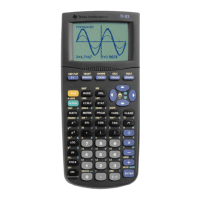818 Appendix A: Functions and Instructions
nCr() MATH/Probability menu
nCr(
expression1
,
expression2
) ⇒
expression
For integer
expression1
and
expression2
with
expression1
‚
expression2
‚
0,
nCr()
is the number of
combinations of
expression1
things taken
expression2
at a time. (This is also known as a binomial
coefficient.) Both arguments can be integers or
symbolic expressions.
nCr(
expression,
0
) ⇒
1
nCr(
expression, negInteger
) ⇒
0
nCr(
expression, posInteger
) ⇒
expression
ø
(
expression
ì
1)
...
(
expression
ì
posInteger
+1)/
posInteger
!
nCr(
expression, nonInteger
)
⇒
expression
!/
((
expression
ì
nonInteger
)!
ø
nonInteger
!)
nCr(z,3)
zø (zì 2)ø (zì 1)
6
ans(1)|z=5 10
nCr(z,c)
z!
c!(zì c)!
ans(1)/nPr(z,c)
1
c!
nCr(
list1
,
list2
) ⇒
list
Returns a list of combinations based on the
corresponding element pairs in the two lists. The
arguments must be the same size list.
nCr({5,4,3},{2,4,2})
¸
{10 1 3}
nCr(
matrix1
,
matrix2
) ⇒
matrix
Returns a matrix of combinations based on the
corresponding element pairs in the two matrices.
The arguments must be the same size matrix.
nCr([6,5;4,3],[2,2;2,2])
¸
[
15 10
6 3
]
nDeriv() MATH/Calculus menu
nDeriv(
expression1
,
var
[
,
h
]
) ⇒
expression
nDeriv(
expression1
,
var, list
) ⇒
list
nDeriv(
list
,
var
[
,
h
]
) ⇒
list
nDeriv(
matrix
,
var
[
,
h
]
) ⇒
matrix
Returns the numerical derivative as an expression.
Uses the central difference quotient formula.
h
is the step value. If
h
is omitted, it defaults to
0.001.
When using
list
or
matrix
, the operation gets
mapped across the values in the list or across the
matrix elements.
Note: See also
avgRC()
and
d
()
.
nDeriv(cos(x),x,h)
¸
ë (cos(xì h)ì cos(x+h))
2ø h
limit(nDeriv(cos(x),x,h),h,0)
¸
ë sin(x)
nDeriv(x^3,x,0.01)
¸
3.ø (xñ +.000033)
nDeriv(cos(x),x)|x=p/2
¸
ë 1.
nDeriv(x^2,x,{.01,.1}) ¸
{2.ø x 2.ø x}
NewData CATALOG
NewData
dataVar
,
list1
[,
list2
] [,
list3
]...
Creates data variable
dataVar,
where the columns
are the lists in order.
Must have at least one list.
list1
,
list2
, ...,
listn
can be lists as shown, expressions
that resolve to lists, or list variable names.
NewData
makes the new variable current in the
Data/Matrix Editor.
NewData mydata,{1,2,3},{4,5,6}
¸
Done
(Go to the Data/Matrix Editor and open the
var
mydata
to display the data variable below.)
NewData
dataVar
,
matrix
Creates data variable
dataVar
based on
matrix
.

